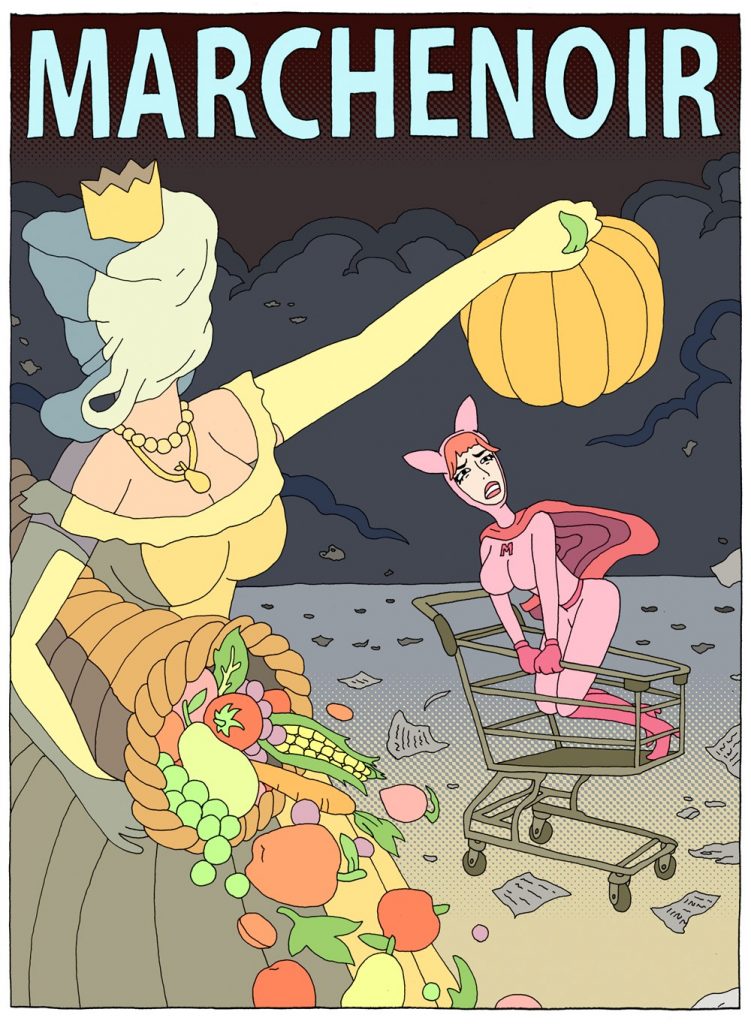
Pleased as I am to see Alex Degen find a new publishing home at Secret Acres, given the impending dissolution of his long-standing “home,” Koyama Press, it’s somewhat curious — though by no means in a bad way — that he chose to introduce himself to a potential new base of readers with The Marchenoir Library, a work that throws down the “take it or leave it” gauntlet rather than easing audiences in his to his idiosyncratic worldview and always-unique approach to cartooning. There’s an audacity to such a move that’s admirable, let there be absolutely no doubt about that, but it’s a textbook example of going against the grain at precisely the point most artists would opt for at least a slightly more populist project.
And yet, counter-intuitive as it may be, that’s likely the best way for anyone to be introduced to Degen’s ouevre, given that compromise has never been part of his repertoire. Time and spatiality and narrative simply work differently in his comics, and never more so than here, where he tells the story of titular character Marchenoir — a one-time singer turned costumed adventurer to get out from under a mountain of debt — through a series of supposed “artifacts,” namely the front and back covers to her long-running comic book series.

It’s a brilliant trope in and of itself, but a risky one — Degen, after a series of “profile”-style pages that fills the reader in on the basics of all his recurring characters — is banking on his skills as an illustrator alone to fill in some of the blanks of this compelling figure whose life and exploits are shrouded in mystery and rumor even in the fictional world he’s illuminating. If you’re wondering if Degen is up to this self-appointed task, rest assured that he is. The inherently fragmentary nature of his admittedly loose narrative gives the project a dreamlike quality to it that’s pitch-perfect given that Marchenoir herself is a guardian (of sorts, at any rate) of both dreaming and waking life.
By and large, The Marchenoir Libraryis an endless series of imaginative visual delights that highlight Degen’s extraordinary composition skills and throw into stark relief the pulp influence that has always been relatively noticeable at the margins in his work. The book itself is by no means purely an exercise in homage, but there’s enough of it on offer to disabuse readers of the notion that he’s operating in an artistic vacuum of any sort, even if his contemporary linework sensibilities and computer-generated colors root this book firmly as a present-day exploration of a past phenomenon.


The Marchenoir Library reminds me of the old cliche about a “mystery wrapped in a riddle inside an enigma”. Every work of art worth its salt leaves the reader or observer with a fair amount of work to do, and Degen does a superb job of leaving a trail of breadcrumbs that can be interpreted in various ways in our own individual quests to fill in his precisely-implemented blanks. You’re given as much information — usually visual information — as he wants you to have, but the final fate of Marhcenoir, as well as why her career is shrouded in a certain amount of secrecy and how she came to be lost to the ages, are questions that he only answers with your own assistance, and there are no clear indications that these covers are even necessarily presented in a strictly linear sequence. Winks and nods to the comics-literate abound, but Degen’s let’s-not-call-it-strictly-narrative technique is so singular that readers with no familiarity with the medium aren’t necessarily more at a disadvantage than veterans. No matter your level of comics experience, then, you’re very much engaged in an act of “co-creation,” as the New Agers would say, with the artist himself as you piece together his clues, as you separate his wheat from his chaff.

By the time all is said and done and you’ve assembled, disassembled, and reassembled everything that you’ve taken in many times over, you’ll find that there’s actually very little chaff here at all, but what’s a mystery without at least a few red herrings? And make no mistake about it: The Marchenoir Library is very much a mystery, in terms of both its construction and its substance. It’s rife with symbolism, arcane concepts, and the air of the hidden, even the borderline-forbidden. Answers are forever within reach, but they are just tantalizingly out of it at the same time. Oblique references to our own consensus reality even put in the occasional appearance by means of vague hints about nefarious goings-on in the cultural and political climate.
Ultimately, though, what Degen seeks to do — and largely succeeds at — is blurring the lines between fantasy and reality, between the conscious and the unconscious, between historical fiction and historical fact. The very phenomenon of identity itself is even subtly called into question in these pastel-hued pages. If you absolutely must, you’ll find answers to all your questions if you look hard enough and are willing to get creative, but by the time you close this book’s covers, you may find that hard-and-fast solutions are a lot less fun than simply pondering the myriad of possibilities that Degen lays at your doorstep.
SOLRAD is made possible by the generous donations of readers like you. Support our Patreon campaign, or make a tax-deductible donation to our publisher, Fieldmouse Press, today.

Leave a Reply